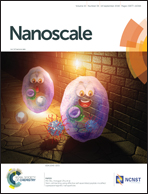Sandwiched spherical tin dioxide/graphene with a three-dimensional interconnected closed pore structure for lithium storage†
Abstract
Low reversion of lithium oxide (Li2O) and the tin (Sn) coarsening causing irreversible capacity loss is the main reason for the poor cycle performance in tin dioxide (SnO2) based composites. In this research, a novel sandwiched spherical tin dioxide/graphene with a three-dimensional interconnected closed pore structure is synthesized. The microstructural characterization shows that the spherical graphene with submicron sized diameters interconnects with each other forming an interconnected flexible conductive network, whereas a large number of SnO2 nanoparticles (approximately 5 nm) are limited homogeneously in between the interlayers of the sphere-like graphene shell. The sandwich structure of the SnO2/graphene and the closed graphene sphere can provide double protection for the SnO2. When it is used as an anode material for energy storage, the generated Li2O can remain in close contact with Sn to make the conversion reaction (SnO2 + 4Li+ + 2e− ↔ Sn + Li2O) highly reversible in situ and the reversibility even does not diminish markedly after 100 cycles. A high reversible specific capacity of 914.8 mA h g−1 is expressed in the sandwiched spherical SnO2/graphene composite at 100 mA g−1 after 100 cycles, which is significantly higher than that of a SnO2/graphene aerogel with an open pore structure.



 Please wait while we load your content...
Please wait while we load your content...